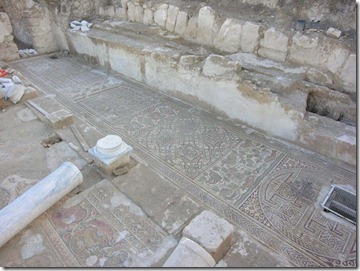A large public building that was turned into a church was recently excavated at Khirbet Midras in the Shephelah. The area was populated in the Second Temple period and is well known for a beautiful rolling stone tomb (since destroyed by vandals).
The archaeologists are suggesting that the church commemorated the burial place of the prophet Zechariah. Given that the sources for this appear to date nearly 1,000 years after Zechariah’s death (c. 500 BC), it may be best to regard this as a dubious Byzantine tradition. Some of the overstated wording of the IAA press release suggests that this claim is going to be the basis for reconstruction and promotion of the site. From the press release:
A public building of impressive beauty dating to the Byzantine period, in which there are several construction phases, was exposed in the excavation. In the last two construction phases the building was used as a splendid church. However, based on the results of the excavation and as evidenced by the artifacts, it seems that this church is built inside a large public compound from the Second Temple period and the Bar Kokhba uprising which was used in the first construction phases of the compound.
The church, in its last phases, was built as a basilica, at the front of which is a large flagstone courtyard from which worshippers passed into an entry corridor. Through a shaped opening one enters into the nave where there were eight breathtaking marble columns that bore magnificent capitals which were specially imported from Turkey. At the end of the nave is a raised bema and on either side of the nave are two wide aisles. All of the floors in the building were adorned with spectacular mosaic floors decorated with faunal and floral patterns and geometric designs that are extraordinarily well preserved. Located behind the bema are two rooms, one paved with a marble floor and the other that led to an underground tomb devoid of any finds. Branching out beneath the entire building is a subterranean hiding complex in which there are rooms, water installations, traps and store rooms. This complex belongs to the large building from the Second Temple period which the Byzantine church was built into. Among the artifacts discovered in the hiding complex are coins from the time of the Great Revolt (66-70 CE) and the Bar Kokhba uprising (132-135 CE), stone vessels, lamps and various pottery vessels that are characteristic of the Jewish population from the settlement at that time.
As previously mentioned, researchers who visited the site are of the opinion that this place is the residence and tomb of the prophet Zechariah. Ancient Christian sources identified the burial place of the prophet Zechariah in the village of Zechariah, and noted that his place of burial was discovered in 415 CE. The researchers believe that in light of an analysis of the Christian sources, including the Madaba Map, the church at Horbat Midras is a memorial church meant to mark the tomb of the prophet Zechariah. This subject will be examined and studied in the near future.
The full story and the two photos posted below are available at the IAA website (also at the MFA website).
Photos courtesy of the Israel Antiquities Authority


3 thoughts on “Byzantine Church Revealed at Khirbet Midras”
You know, if almost anywhere else in the world you found the well preserved and beautiful remains of a 1500 year old building, they would almost instantly be heralded as a national treasure and be flooded with visitors. In Israel, this spot only becomes interesting if you can connect it to Zachariah.
O, the unloved Byzantines!
I beg to differ. The place was packed with Israelies during the week end and will probably continue to be so for the next week, until the site is covered up.
Please keep in mind this site will be covered up soon if not already … I'm not sure why the IAA would be motivated to make excessive claims. I was there a few days ago with two capable archaeologists. The tomb may be 1st century according to those I talked with. The stone is almost round on the bottom, not on the top, and is not perfectly formed like the rolling stone at the so-called Herod's family tomb.